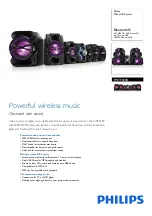
ABOUT HIGH DEFINITION MICROPHONES™
During the last decade it has become commonplace for sound recording
and broadcast equipment to accommodate extended frequency responses
up to and beyond 100kHz. With few exceptions, even the very best of
conventional professional microphones do not offer frequency responses
above 20kHz. However, making a High Definition Microphone™ involves far
more than extending the frequency response. Impulse response, diaphragm
settling time and pristine low distortion high current electronics are also
key elements. Earthworks’ founder David Blackmer foresaw the need for
higher quality microphones. Earthworks has been offering High Definition
Microphones™, with extended frequency response beyond 40kHz, since
1996. Earthworks High Definition Microphones™ have an extremely clean,
natural on-axis pickup, and smooth, uncolored off-axis response due
to their near-perfect polar patterns. Cardioid models of High Definition
Microphones provide high front-to-back rejection that makes them superb
for a wide range of applications including sound reinforcement, broadcast
in addition to recording of voice and musical instruments. You will hear
exceptional sound quality that is extremely accurate, detailed, open and
crystal clear even on 16 bit, 44.1kHz recording systems as well as analog
or digital sound systems that are limited to a 15kHz or 20kHz bandwidth.
You will hear a remarkable improvement in sound quality on nearly all
audio systems when using Earthworks High Definition Microphones™.
EXTENDED FREQUENCY RESPONSE
The FlexWand™ System incorporates a High Definition Microphone™
with a
30kHz high frequency response that enables it to pick up high frequency
overtones that conventional microphones miss. In addition, it’s extremely
fast impulse response that allows it to pick up transients far more accurately.
The exceptionally short diaphragm settling time will enable you to hear subtle
details that conventional microphones mask. The audible difference between
an Earthworks High Definition Microphone™ and conventional microphones
is as dramatic as the difference you see when comparing conventional video
and high-definition video. It is most impressive. We again urge you to care
-
fully read the next 8 pages to gain a greater understanding of how fully utilize
the FlexWand™ System.
2
Utilizing Earthworks Near-perfect Polar Response
Near-perfect Polar Response
Conventional cardioid microphones typically have poor polar response. They
will have a relatively uniform (i.e. flat) frequency response at the front of the
microphone (on-axis or 0 degrees), meaning they will uniformly reproduce
high frequencies, mid frequencies and low frequencies with a uniform level.
However, if you move to either side of the microphone (90 or 270 degrees)
there will be a dramatic loss in high frequency response. Perhaps the most
telling demonstration of this is attempting to place three singers on a single
conventional cardioid microphone (one at the front and the other two sing-
ers on the sides). The singers on the sides of the microphone will sound
muddled and undefined due to the loss of high frequencies at the sides of
the microphone (off-axis). In figure 1a you will see a perfect cardioid polar
pattern which will pick up all frequencies uniformly at the front and the sides
of the microphone. Figure 1b shows the polar response of a typical conven-
tional cardioid microphone. Notice the severe loss of high frequencies at
the sides of the microphone. Figure 1c is the near-perfect polar response
of an Earthworks microphone. The Earthworks microphone has a uniform
frequency response at the sides of the microphone that is within 3db of the
on-axis response at any frequency.
The Earthworks cardioid microphones will pick up sounds with nearly the same
fidelity at the front and the sides of the microphone. This is a remarkable
technical achievement and one that will provide incredible results for you.
Figure 1.
Differences Between a Perfect, Conventional and an Earthworks Cardioid Microphone
(1b) Conventional Cardioid Microphone
(1c) Earthworks Cardioid Microphone
(1a) Textbook
Perfect Cardioid
Microphone
3
THE UNIQUE TECHNOLOGY INCORPORATED IN THE FLEXWAND™ WILL PROVIDE
EXCEPTIONAL RESULTS. HOWEVER, THESE MICROPHONES DO NOT WORK LIKE
CONVENTIONAL MICROPHONES, SO TO ACHIEVE THE GREATEST RESULTS, PLEASE
TAKE THE TIME TO READ THE NEXT FEW PAGES:



























